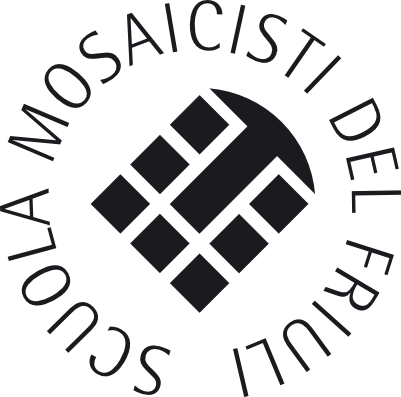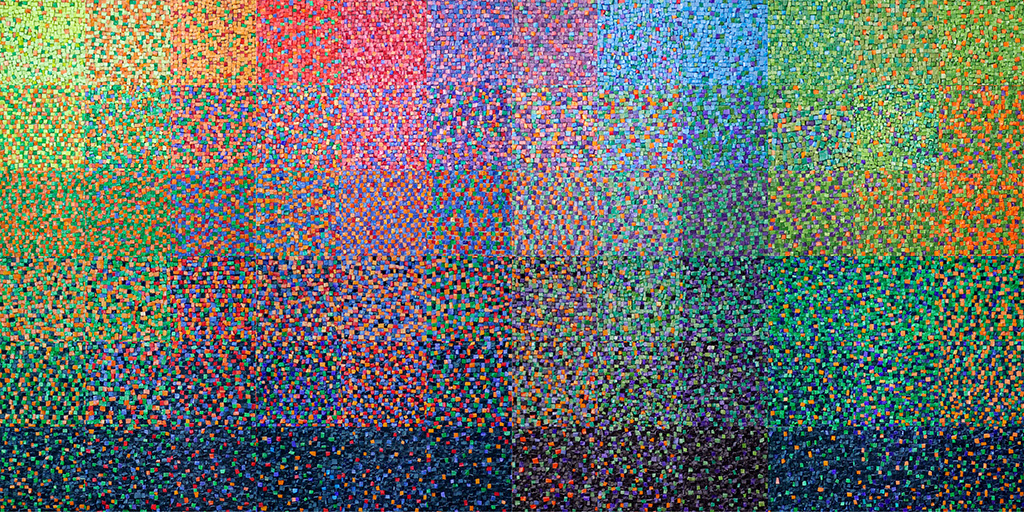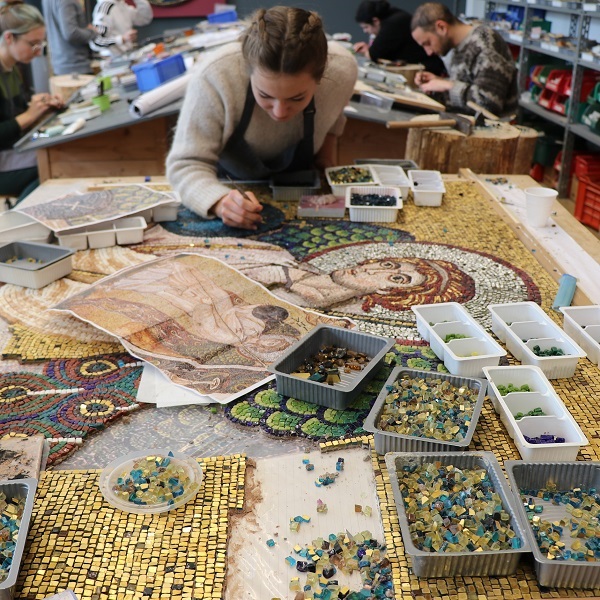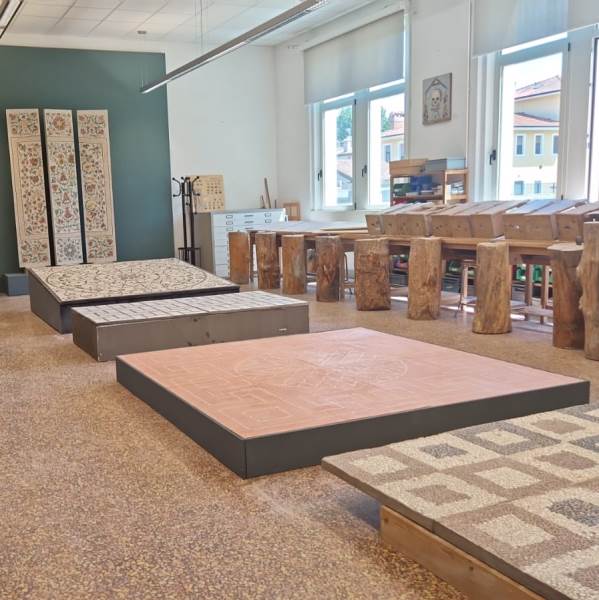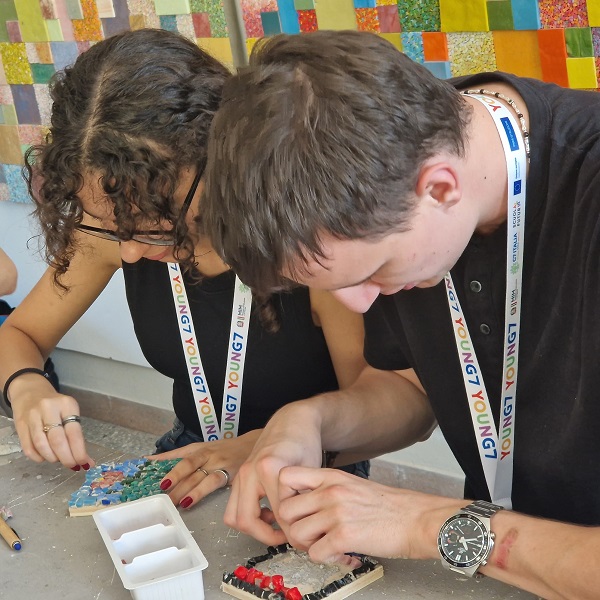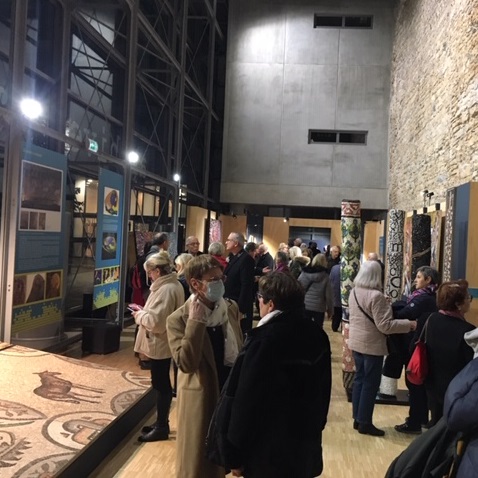
Lyon is hosting an exhibition on the Scuola Mosaicisti del Friuli
The Scuola Mosaicisti del Friuli, on the occasion of its one hundred years of activity, was invited to exhibit its works in Lyon, a French city in which the art of mosaic finds important evidence.
The major exhibition, set up at the Archives municipales de Lyon, opened on Tuesday 22 November 2022 at 6.00 pm and will be open until Saturday 8 April 2023. Born from the collaboration between the Municipality of Lyon, the Italian Cultural Institute of Lyon, the Friuli Venezia Giulia Region, the Ente Friuli nel Mondo, the Fogolar Furlan of Lyon and of course the Scuola Mosaicisti del Friuli, it presents a selection of works mosaic made by the School itself, by its students who study and train here to become Master Mosaicists. An event that saw a large public participation, a confirmation of the excellence that the Scuola Mosaicisti del Friuli represents, but also of the historic link between the city of Lyon and Friuli Venezia Giulia expressed precisely through the mosaic.
The deputy mayor of Lyon, delegate for culture, Nathalie Perrin-Gilbert and the Italian consul in Lyon Pierangelo Cammarota did the honors at the inauguration. Greetings followed from the regional councilor Barbara Zilli, the president of the Scuola Mosaicisti del Friuli Stefano Lovison and the president of the Ente Friuli nel Mondo Loris Basso together with Danilo Vezzio President of Fogolar Furlan in Lyon.
The critical introduction to the exhibition was entrusted to Henri Lavagne, president of the Académie des Inscriptions et Belles-Lettres and author of the famous essay The mosaic through the centuries, and to Gian Piero Brovedani, director of the Scuola Mosaicisti del Friuli, promoter and curator of initiatives for the study and enhancement of the art of mosaic.
The number and variety of works on display offers the possibility of retracing the stylistic evolution of the mosaic over the centuries. It begins with the Roman mosaic of some copies of details taken from the vast floor surfaces of Aquileia. A UNESCO World Heritage Site since 1998 precisely because of the value of its mosaics, Aquileia represents the best-known reference of the mosaic tradition in Friuli Venezia Giulia, which can thus boast ancient origins.
The examples of Byzantine mosaics are significant, among which the large panel that reproduces, in the original sizes, Hell as it is described, with the monstrous Satan, in one of the scenes depicted on the dome of the Baptistery of San Giovanni in Florence stands out. Dante Alighieri loved that building and that rich mosaic decoration, which meticulously described the Last Judgment with the clear division between the blessed and the damned forced to terrible tortures, certainly struck his imagination. Just as the “language of Dante” has transformed over the centuries to maintain its communicative function, mosaic art has also grown, opening up to proposals for innovative materials and technologies and, above all, responding to new expressive needs. From the ancient mosaic therefore to the contemporary one, remembering how France and the city of Lyon itself preserve very high examples of that modern style which gave new vigor to the art of mosaic in the Nineteenth century. How not to mention Gian Domenico Facchina, a mosaicist from Sequals, who entered the ranks of great artists thanks to his feat at the Opéra Garnier in Paris (1875) and with him many other Friulian craftsmen called to cover large surfaces with elaborate and elegant compositions. The Basilica of Notre-Dame de Fourvière in Lyon for its mosaic decoration is undoubtedly among the most important monuments of this period. The Friulian mosaicists with their skills and qualities, around Europe and beyond, left significant traces of their art and from 1922 the Scuola Mosaicisti del Friuli in Spilimbergo inherited the knowledge and experience gained to start training ready young to learn a trade and to travel the world. It is therefore not surprising that the restoration of the wall mosaics of the Basilica of Lyon in 2012 saw the participation of a laboratory founded by former students of the School. A similar story in 2002-2003 is the restoration entrusted to the School of Chapel 13, of Pentecost and the Earthly Paradise, of the Sanctuary of Lourdes whose grandiose decoration bears the signature of Gian Domenico Facchina.
In the exhibition, a large section is dedicated to the present and to the research that the School carries out on contemporary mosaic. In respect of tradition and that “know-how” of artistic craftsmanship, the School opens up to current needs and tastes, deepening the aspects related to planning, dialoguing with three-dimensionality, design, coeval expressive forms, responding to requests of furnishing internal spaces, but also external ones, for public use. It is here that the exhibition leaves the historical narrative to look to the future with innovative and functional proposals. In these mosaic sculptures, in everyday objects dressed in uniqueness and beauty, in the elaborate panels capable, thanks to colors and workmanship, of transforming neutral spaces into exclusive and quality places, in these works we understand why the Scuola Mosaicisti del Friuli is an international center for training in the art of mosaic, an institution capable of attracting students from all over the world and then returning Master Mosaicists, heirs and continuators of a millenary art, yet still so current.
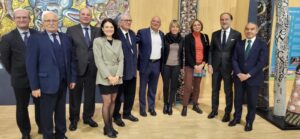
The representatives of the Organizations and Institutions involved in the Lyon exhibition
23 November 2022


